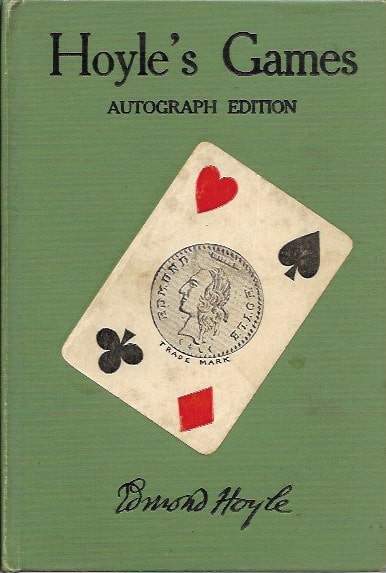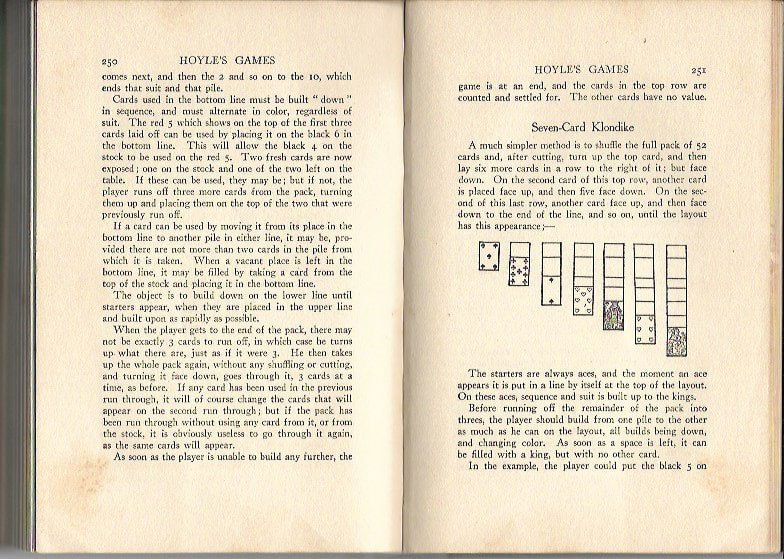- Name Book: Hoyle’s Games – Autograph Edition
- Author: Unknown
- Year: 1907
- Publisher: McClure Company
- Location: New York, USA

Hoyle’s Games – Autograph Edition by the McClure Company, New York, USA 1907
The pictures from this book are taken from a later publication revised by R.F. Foster and published in New York by the L. Burt Company.
Edmond Hoyle (1672 – 1769) was a famous writer for his books on the rules and play of various card games. His fame as a rules writer grew to such an extent that the word Hoyle represented a kind of reliability. Partly because of this, the name Hoyle was used for game rule books long after his death.
The Hoyle’s Games – Autograph Edition has some remarkable game descriptions and name givings.
- The game described as Gambling House Solitaire in the newspaper article “Gambling House Solitaire is popular in Brooklyn” is suddenly called “Klondike.”
- The game we know today as Vegas Solitaire (Klondike including gambling score) is named Seven Card Klondike.
About Klondike (page 248)

“There are several ways of playing this game, the following being probably the original form. The banker sells a pack of 52 cards for $52, and he agrees to pay 5$ for every card the player gets down in the top-line so that if he gets 11 or more down, he wins. If he gets ten or less, he loses. The pack is shuffled by the player and cut by the banker.”
“The pack is shuffled by the player and cut by the banker. Holding it face down, 13 cards are counted off for the stock.” The stockpile is placed face-up on the player’s left. The next card on the pack is turned face up for a “starter” and is put in the ^’ top line,” further from the player. Let us suppose it to be the jack of spades. All the starters for this deal will then be jacks, and nothing but jacks can be put in the top line, except cards that will build upon jacks already there.”
About Seven-Card Klondike (page 251)

“A much simpler method is to shuffle the full pack of 52 cards and, after cutting, turn up the top card, and then lay six more cards in a row to the right of it, but face down.
On the second card of this top row, another card is placed face-up, and then five faces down. On the second of this last row, another card faces up, and then face down to the end of the line, and so on, until the layout has this appearance.
The starters are always aces, and the moment an Ace appears, it is put in a line by itself at the top of the layout.
On these aces, sequence and Suit is built up to the kings.Before running off the remainder of the pack into threes, the player should build from one pile to the other as much as he can on the layout, all builds being down and changing color.
As soon as a space is left, it can be filled with a king but with no other card.
The moment a card is taken away to another file, the card under it is turned face up and is available for building.
In this game, the player is not allowed to borrow a card from one file unless it is the only card on that file, face-up, or unless he can take all the cards that are face-up together.
Payments are made for all the cards in the ace line; that is, for all aces and cards in sequence and Suit with them showing on the top line. As soon as the player is no longer able to make a change by running off the pack in threes, the game is at an end.
Another way to play is to run off the pack one card at a time instead of in threes. When this is done, the pack is gone over once only, and that ends it.”
The Confusion between Klondike, Seven Card Klondike, and Canfield
The fact that Edmond Hoyle is using “Klondike” instead of “Gambling House Solitaire” or “Canfield” to point out the 4-card foundation / 13-card reserve layout is remarkable.
It’s the first time that Klondike is used as a name for Solitaire; however, it is used for the Canfield, 4-card style layout.
It is also the first time we read the name Seven Card Klondike, which seems to be the original name for the game we call Vegas Solitaire today (or Klondike as you wish, but including the gambling scoring and played with the one card draw rule.)
The fact that the name Klondike is used here for Canfield and Vegas Solitaire is fascinating but adds massively to the confusion between the names given to the four-card Canfield or the Seven Card Klondike game.
Which One was played at Canfield’s Casino?
There are rumors about a letter where Canfield states that he offered Seven Card Klondike in his gambling House in New York City (not Saratoga). Seven Card Klondike was taught to him by a sourdough from Alaska, where this form of Solitaire was played in gambling houses during the gold rush. Read more about that in the article “What Solitaire was played in Canfields Casino?“
